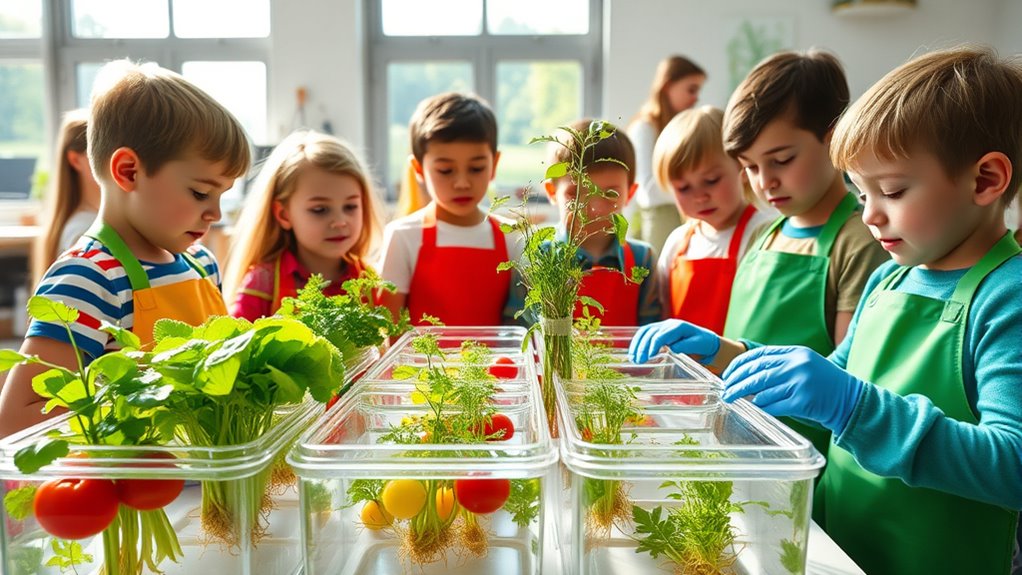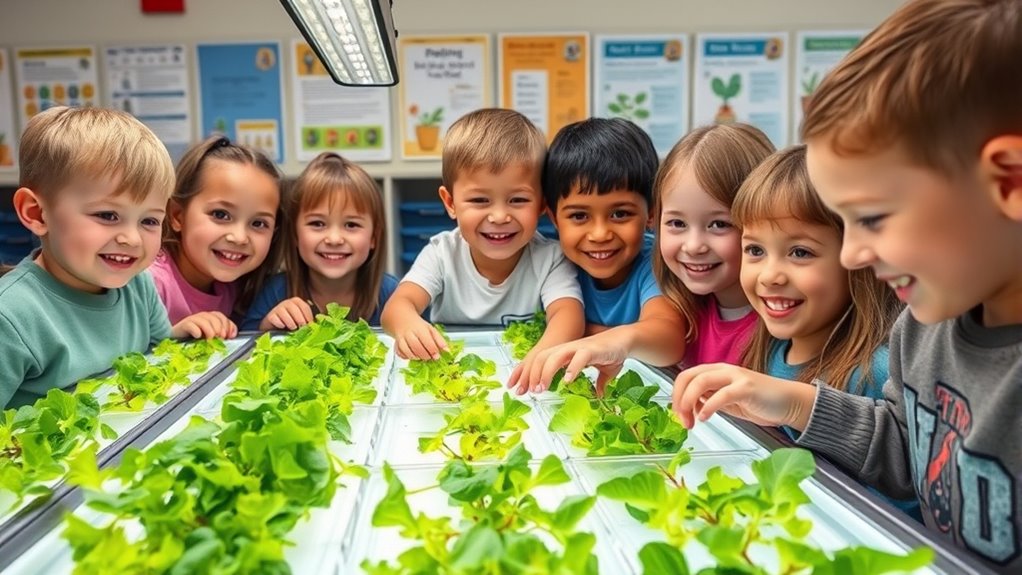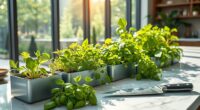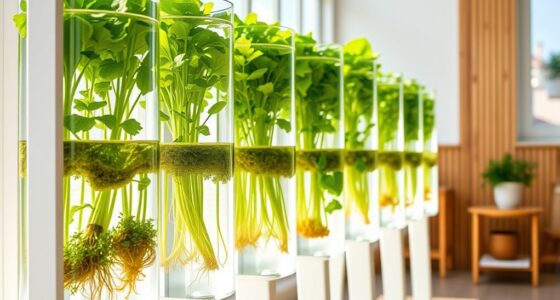Hydroponics is a fun way for kids to learn about how plants grow without soil. You can set up a simple system with water, nutrients, and your favorite plants or seeds. Watching roots develop and observing the different growth stages makes science interactive and exciting. By experimenting with nutrient levels and light, you get to see firsthand how plants thrive. Keep exploring for more tips and ideas to make your hydroponic adventure even more fun!
Key Takeaways
- Conduct simple hydroponic experiments to teach kids about plant growth without soil.
- Use transparent systems to visually observe roots and nutrient absorption.
- Compare plant development in soil versus hydroponic setups for hands-on learning.
- Incorporate fun activities like changing nutrient solutions or light conditions.
- Highlight the benefits of hydroponics, such as faster growth and easy environment control, to engage children.

Hydroponics is a fun and educational way for kids to learn about how plants grow without soil. When you compare soil versus hydroponics, you’ll notice some key differences that make hydroponics a mesmerizing science experiment. In traditional soil gardening, plants depend on the soil’s nutrients, microorganisms, and structure to grow. In hydroponics, plants are grown directly in a nutrient-rich water solution, which allows for faster growth and easier control over their environment. This setup helps you see firsthand how plants go through their growth stages, from sprouting to maturity, without the interference of soil variables. Watching a seed sprout in a hydroponic system can be more straightforward because you can observe root development directly in the water, unlike in soil where roots spread out and hide beneath the surface. Soil versus hydroponics is a fundamental comparison that highlights the advantages of water-based systems. Understanding plant growth stages is essential to grasp how hydroponics works. When you start with a seed or seedling, you’ll notice the initial germination phase, where the seed sprouts and roots begin to develop. In hydroponics, this process is often quicker since roots have direct access to nutrients and oxygen. As the plant enters the vegetative stage, it develops leaves and more extensive roots, which you can easily monitor in your system. During this phase, your plants require proper light, nutrients, and water, all of which you can control precisely in a hydroponic setup. Finally, the flowering or fruiting stage comes, where flowers bloom or fruits develop. Seeing these stages happen right before your eyes helps you understand how plants grow and what they need at each point. Growing plants hydroponically also offers a clear comparison to soil-based growth. You’ll find that hydroponic systems often lead to faster plant development because nutrients are readily available and delivered efficiently. Plus, since you’re not using soil, there’s less mess, fewer pests, and less worry about soil-borne diseases. This simplicity makes it easier for kids to learn about plant needs and observe growth closely. You can also experiment with different nutrient mixes to see how they influence each stage of growth, giving you a hands-on understanding of plant nutrition.
Frequently Asked Questions
Can Hydroponics Be Used to Grow All Types of Plants?
You might wonder if hydroponics can grow all plant varieties, but it’s not always possible. Some plants have specific growth limitations or need soil nutrients that hydroponic systems can’t fully replicate. While many vegetables and herbs thrive, certain root crops or plants with extensive root systems may not do well. So, understanding each plant’s growth needs helps determine whether hydroponics is suitable for your preferred plant variety.
What Safety Precautions Should Kids Take During Hydroponic Experiments?
When doing hydroponic experiments, you should always prioritize safety. Wear safety gear like gloves and goggles to protect your skin and eyes from any chemicals or nutrient solutions. Make sure your experiment is supervised by an adult to guarantee proper handling and safety procedures. Always follow instructions carefully, handle equipment carefully, and wash your hands afterward. These precautions help keep your experiment fun and safe while you learn about plant growth.
How Much Space Is Needed for a Simple Hydroponic Setup?
You’re really asking about space requirements for a simple hydroponic setup—think of it as having just enough room to spread your wings. Usually, you need a small table or shelf, around 2×2 feet, for the setup size. This gives you enough space to fit containers, a water reservoir, and lights without crowding. It’s a manageable project that fits comfortably in a kitchen corner or windowsill.
Is Electricity Required for Hydroponic Systems Suitable for Children?
You might wonder if electricity is needed for hydroponic systems suitable for children. The good news is, many systems don’t require electricity, making them safer and easier to manage. If you do use powered systems, prioritize electricity safety by ensuring proper wiring and supervision. Powering hydroponics can be simple and safe with the right precautions, allowing kids to learn and enjoy growing plants without unnecessary risks.
How Long Does It Typically Take to See Plant Growth in Hydroponics?
You’re enthusiastic to see those first signs of life, but how long will it be? Typically, in hydroponics, you can expect seed germination within 3 to 7 days, depending on the plant. Once germinated, plants rapidly absorb nutrients through their roots, leading to visible growth in just a couple of weeks. Patience pays off as you watch your hydroponic garden flourish, revealing the magic of science and nature working together.
Conclusion
As you nurture your hydroponic garden, you’re planting more than just roots—you’re cultivating curiosity, patience, and growth. Each tiny sprout symbolizes your journey into science and discovery, reminding you that learning is a seed that flourishes with care. Watch how your efforts bloom into vibrant life, turning education into a joyful adventure. With every leaf, you’re not just growing plants, but also inspiring a lifelong love for exploration and the endless possibilities that come with nurturing nature.








